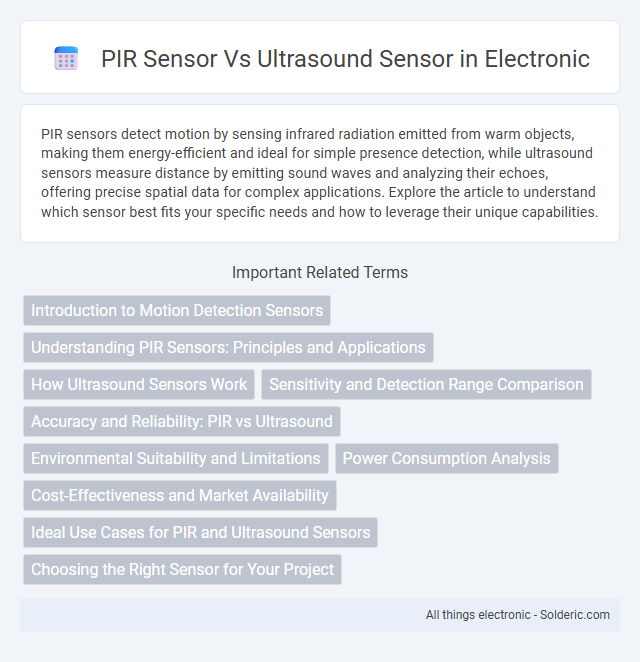PIR sensors detect motion by sensing infrared radiation emitted from warm objects, making them energy-efficient and ideal for simple presence detection, while ultrasound sensors measure distance by emitting sound waves and analyzing their echoes, offering precise spatial data for complex applications. Explore the article to understand which sensor best fits your specific needs and how to leverage their unique capabilities.
Comparison Table
| Feature | PIR Sensor | Ultrasound Sensor |
|---|---|---|
| Detection Principle | Infrared radiation from heat-emitting objects | High-frequency sound wave reflection |
| Detection Range | Up to 7 meters | Up to 10 meters |
| Field of View | Typically 110deg | Typically 15deg to 30deg beam angle |
| Cost | Low | Moderate to high |
| Power Consumption | Very low | Moderate |
| Sensitivity to Environment | Affected by temperature and direct sunlight | Affected by soft materials and sound absorbent surfaces |
| Application | Motion detection, security alarms, lighting control | Distance measurement, obstacle detection, robotics |
| Response Time | Fast | Moderate |
| Output Type | Digital signal (motion detected or not) | Analog or digital distance data |
Introduction to Motion Detection Sensors
PIR sensors detect motion by measuring changes in infrared radiation emitted by warm objects, making them highly effective for indoor security and energy-saving lighting systems. Ultrasound sensors use high-frequency sound waves to map the environment and detect moving objects through reflected signals, offering precise distance measurement and detection in various weather conditions. Your choice between PIR and ultrasound sensors depends on the application's need for sensitivity to heat signatures or distance accuracy in motion detection.
Understanding PIR Sensors: Principles and Applications
PIR sensors detect infrared radiation emitted by warm objects, making them ideal for motion detection in security and automation systems. These sensors operate by measuring changes in heat levels within their field of view, triggering alerts when a moving person or animal is detected. You can rely on PIR sensors for energy-efficient occupancy detection and intrusion alarms, especially in indoor environments.
How Ultrasound Sensors Work
Ultrasound sensors operate by emitting high-frequency sound waves that reflect off objects and return to the sensor, allowing it to measure distance based on the time delay between emission and reception. These sensors leverage echolocation principles to detect objects and calculate precise distances in various environments. Unlike PIR sensors that detect infrared radiation from heat sources, ultrasound sensors provide accurate range detection regardless of object temperature.
Sensitivity and Detection Range Comparison
PIR sensors detect motion through changes in infrared radiation and offer high sensitivity to heat but generally have a limited detection range of 5 to 12 meters. Ultrasound sensors measure distance by emitting sound waves, providing a more precise detection range of up to 10 meters and better performance in detecting stationary objects. Your choice between PIR and ultrasound sensors depends on whether you prioritize detecting motion of warm objects or accurately measuring distances in various environments.
Accuracy and Reliability: PIR vs Ultrasound
PIR sensors detect infrared radiation from heat sources, providing reliable motion detection with low false alarms but limited range and precision. Ultrasound sensors emit high-frequency sound waves, offering higher accuracy in distance measurement and object detection but can be affected by environmental factors such as noise and surface texture. For applications requiring precise object location, ultrasound sensors outperform PIR sensors, while PIR sensors excel in energy-efficient presence detection.
Environmental Suitability and Limitations
PIR sensors excel in detecting human motion through infrared radiation, making them ideal for indoor environments with stable temperature conditions but less effective outdoors due to sunlight interference and temperature fluctuations. Ultrasound sensors emit sound waves to measure distance and detect objects, functioning reliably in various lighting conditions and outdoor settings but struggling with soft materials that absorb sound or irregular surfaces causing reflection errors. Environmental factors such as temperature variability, lighting conditions, and surface characteristics significantly influence the performance of PIR and ultrasound sensors, dictating their suitability for specific applications.
Power Consumption Analysis
PIR sensors typically consume very low power, often in the range of microamps during standby, making them ideal for battery-operated and energy-efficient applications. Ultrasound sensors generally require higher power to emit and receive sound waves, with consumption varying from milliamps to tens of milliamps depending on measurement frequency and range. The significant difference in power consumption positions PIR sensors as the preferred choice for continuous motion detection with minimal energy use, while ultrasonic sensors suit applications where precise distance measurement outweighs power constraints.
Cost-Effectiveness and Market Availability
PIR sensors are typically more cost-effective due to their simpler technology and widespread production, making them a popular choice for basic motion detection applications. Ultrasound sensors, while generally more expensive, provide precise distance measurement and object detection, which justifies their higher price in specialized markets. Both sensors enjoy broad market availability, but PIR sensors dominate budget-sensitive segments, whereas ultrasound sensors are common in industrial and robotics sectors.
Ideal Use Cases for PIR and Ultrasound Sensors
PIR sensors excel in detecting human motion and body heat, making them ideal for indoor security systems, automatic lighting, and occupancy sensing where presence detection is crucial. Ultrasound sensors use sound waves to measure distance and detect objects, perfect for robotics, object avoidance, and level measurement in tanks or containers. Your choice depends on whether you need precise distance measurement and object detection (ultrasound) or reliable presence detection of living beings based on heat signatures (PIR).
Choosing the Right Sensor for Your Project
PIR sensors excel in detecting human motion by sensing infrared radiation, making them ideal for energy-efficient lighting and security systems. Ultrasound sensors measure distance using sound waves, providing precise object detection and range measurement for robotics and automation. Selecting the right sensor depends on project requirements: use PIR for passive motion detection and ultrasound for accurate proximity sensing.
PIR sensor vs ultrasound sensor Infographic

 solderic.com
solderic.com